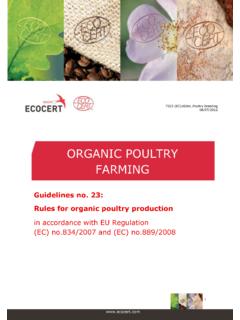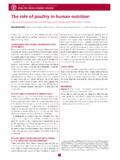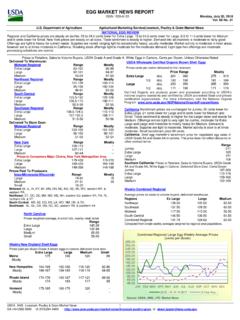Transcription of Algae Products in Organic Poultry Diets
1 Algae Products in Organic Poultry Diets Lizza M. Macalintal, University of Kentucky Algae , the not so new kid on the block has been used in both human and animal Diets dating back centuries. There is a renewed interest in supplementing animal Diets with defatted microalgae due to its nutritional and bioactive components. Algae is cultivated for biofuel production pharmaceutical, cosmetics and food manufacture. Classification of Algae is complex however, it can be subdivided according to their structure and size. Macroalgae, are large multicellular plant-like floating masses commonly referred to as seaweeds. Microalgae, on the other hand, are free-living tiny unicellular organisms found in marine environment and freshwater. They are a diverse group of photoautotrophs which serve as essential food for larval and early-juvenile stages of crustaceans and fish (Brown et al.)
2 , 1989). Advanced technologies enable the algal industry to culture and process microalgae indoors. Using photobioreactors which are closed, controlled system with the ability to ferment a more consistent, stable and contaminant-free Algae product. Algae Products are good sources of protein, vitamins, trace minerals, antioxidants, pigments, carbohydrates and fatty acids but more importantly contains high amounts of the beneficial polyunsaturated fatty acids omega-3 (n-3) fatty acids, particularly eicosapentaenoic acid (EPA) and docosahexaenoic acid (DHA). The beneficial effects of polyunsaturated fatty acids in human health sparked the interest in supplementing Poultry Diets with defatted microalgae to increase its nutritive value including that of the n-3 fatty acids. Microalgae and its nutritive value The nutritional value of microalgae typically varies between species depending on its cell size and structure, bioactive components, and culture or growing conditions.
3 Although variations in nutritive value occur, protein (6-63%), carbohydrates (8-64%) and lipids (2-50%) are the major nutritional components found in Algae . Selected microalgae species when compared to conventional feed ingredient, such as corn, soybean and wheat, are similar in nutrients if not better (Table 1). The FAO. reported that soybean, a traditional protein source in food-producing animal Diets , has an amino acid profile which is comparable to the microalgae Chlorella and Spirulina (Becker, 2007). Furthermore, they also contain the essential amino acids that cannot be synthesized by the body but had to be acquired through the diet. Spirulina and chlorella spp. are cultivated on a commercial scale and are available as human health food supplements. The US Food and Drug Authority considered them as generally regarded as safe (GRAS) and are marketed as functional food due to its high value-added nutrient contents.
4 Another microalgae of interest is Schizocythrium sp for its ability to incorporate more polyunsaturated fatty acids like n-3 fatty acids in eggs and chicken meat Products . The n-3 fatty acids derived from microalgae include EPA and DHA. Algae are neither plants nor animals, but they do possess characteristics of being like both plants and animals. They are aquatic plant-like organisms, in the sense that Algae make their own food ( chlorophyll) through photosynthesis. Algae traps energy from the sun to convert carbon dioxide and water to Organic molecules carbohydrates, lipids and proteins. And like animals, Algae are capable of feeding on Organic materials found in their surrounding environment and eat their grazers as well. Marine Algae are acceptable to people who are vegetarians as a source of EPA and DHA, hence, it is also acceptable in vegetarian Poultry Diets .
5 Algae are naturally non-genetically modified organisms. Genetic modification happens when a gene/s are physically transplanted and inserted into another organism, which then changes the acceptor's genetic make-up. The primary interest in genetically modifying Algae , is due to Algae 's ability to produce high amounts of lipids (triglycerides) which is the basis for biofuel production (Pate et al., 2011). In 2017, scientists from the University of San Diego has genetically engineered Acutodesmus dimorphus for fatty acid biosynthesis and green fluorescent protein expression which is not present in non-altered Algae . The caveat of this process, just like in other GMO Products is the threat it possesses on the ecosystem and possible mutation. Hence, the source of Algae Products will determine its non- GMO status.
6 Table 1. Comparison of nutritional composition of selected microalgae and conventional feed ingredients, (% dry matter). Source Protein Carbohydrates Lipids Corn 10 85 4. Soybean 37 30 20. Wheat 14 84 2. Chlorella vulgaris 51-58 12-17 14-22. Chlorella pyrenoidosa 57 26 2. Spirullina platensis 46-63 8-14 4-9. Spirogyra sp 6-20 33-64 11-21. Synchecococus sp 63 15 17. Schyzochitrium sp 14-20 25 40-50. *(adapted from : Lum et al., 2013 ; Pyle et al., 2008 ; Becker, 2007). Microalgae in Poultry Diets Extensive Poultry studies have been conducted on using various fats and oil seeds from plants and/or marine sources to increase the levels of fatty acids deposition in eggs and chicken meat. However, marine or plants sources are mainly rich in essential linoleic or -linolenic acid (ALA) from which EPA and DHA are synthesized.
7 Flaxseed is an oilseed typically added to Poultry Diets because of its high ALA content precursor for DHA. As much as flaxseed is a good source of the ALA, it also contains anti-nutritive factors. Supplementation of flaxseed at 10-15% in laying hen or broiler Diets greatly reduced the bodyweight of birds (Mridula et al, 2014; Bean and Leeson 2003; Novak and Scheideler, 2001; Ajuyah, et al., 1993). As for marine sources of fatty acid, the unsustainability of fish oil supplies is a major feed industry concern (Kitessa et al, 2014). In addition, dietary addition of fish oil (> ) has been reported to affect the sensory quality in eggs and is often described to have off- flavor (Gonzalez-Esquerra and Leeson 2000; Holdas and May, 1966) which may affect consumer acceptability. Fatty acids are added to the diet to increase energy density to improve Poultry productivity and feed efficiency (NRC, 1994).
8 However, not all fats or lipids are created equal and most certainly the types and amount of fats deposited into different body tissues will not yield similar effects. Recently, the beneficial effects of modifying the fatty acid composition of Poultry Diets has also been shown to have potential beneficial effects on human health. Consumption of food Products enriched with n-3. polyunsaturated fatty acids (n-3 PUFA) is positively linked to multiple health benefits in human population (Simopoulos 2001, 2006) including but not limited to cardiovascular diseases, arthritis, diabetes, cancer and neurodegenerative conditions. Thus, there is an increasing demand to fortify food Products including eggs and chicken meat and Poultry Diets with n-3 PUFA with emphasis on DHA. An alternative and sustainable source of fatty acids for Poultry diet is the marine-based microalgae Schizochytrium sp.
9 , which contain relatively high concentrations of n-3 PUFA, particularly EPA and DHA (Jiang et al., 2004; Hauvermale et al., 2006; Metz et al., 2009). Microalgae are maybe at the bottom of the food chain however, they are the direct source of the beneficial n-3 fatty acids. About 29% of the total lipid content of microalgae is n-3-fatty acids (Barclay et al., 1998) of which 25% is DHA. Docosahexaenoic acid is important in membrane structure and neuronal integrity as well as visual acuity (Bradbury, 2011), therefore deficiency in DHA can impair growth and susceptibility to certain diseases may be increased. Microalgae and Eggs In laying hen studies using Spirulina ( ) or Chlorella (up to 1%), yolk color was enhanced and the productive performance was not affected. Hens fed a diet supplemented with either Spirulina or Chlorella, had eggs with yolks that were significantly richer in color (An et al.)
10 , 2014; Zahroojian et al., 2011; 2013) which can be attributed to the presence of carotenoids. Carotenoids are fat-soluble pigments present in algal biomass and is a known precursor of vitamin A. In a more recent experiment, two feeding trials were carried out to determine the influence of the dietary addition of microalgae (Schizochytrium limacinum) on the fatty acid composition of eggs. Layer hens were fed a corn-soybean meal-based diet containing microalgae at 0, , 1, 2 or 3%. respectively. Fatty acid determination revealed that feeding layer hens with graded levels of microalgae resulted in corresponding increases in DHA deposition in eggs (Table 2). Compared to the market egg which contained 58 mg DHA/100g (USDA, Nutrient Data Lab), the eggs from microalgae- fed hens had a higher DHA content that ranged from 74 to 137 mg DHA/100g egg respectively.








